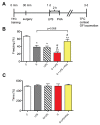Stimulation of the α7 nicotinic acetylcholine receptor protects against neuroinflammation after tibia fracture and endotoxemia in mice
- PMID: 25365546
- PMCID: PMC4398668
- DOI: 10.2119/molmed.2014.00143
Stimulation of the α7 nicotinic acetylcholine receptor protects against neuroinflammation after tibia fracture and endotoxemia in mice
Abstract
Surgery and critical illness often associate with cognitive decline. Surgical trauma or infection can lead independently to learning and memory impairments via similar, but not identical, cellular signaling of the innate immune system that promotes neuroinflammation. In this study we explored the putative synergism between aseptic orthopedic surgery and infection, the latter reproduced by postoperative lipopolysaccharide (LPS) administration. We observed that surgery and LPS augmented systemic inflammation up to postoperative d 3 and this was associated with further neuroinflammation (CD11b and CD68 immunoreactivity) in the hippocampus in mice compared with those receiving surgery or LPS alone. Administration of a selective α7 subtype nicotinic acetylcholine receptor (α7 nAChR) agonist 2 h after LPS significantly improved neuroinflammation and hippocampal-dependent memory dysfunction. Modulation of nuclear factor-kappa B (NF-κB) activation in monocytes and regulation of the oxidative stress response through nicotinamide adenine dinucleotide phosphate (NADPH) signaling appear to be key targets in modulating this response. Overall, these results suggest that it may be conceivable to limit and possibly prevent postoperative complications, including cognitive decline and/or infections, through stimulation of the cholinergic antiinflammatory pathway.
Figures







References
-
- Moller JT, et al. Long-term postoperative cognitive dysfunction in the elderly ISPOCD1 study. ISPOCD investigators. International Study of Post-Operative Cognitive Dysfunction. Lancet. 1998;351:857–61. - PubMed
-
- Riedel B, Browne K, Silbert B. Cerebral protection: inflammation, endothelial dysfunction, and postoperative cognitive dysfunction. Curr Opin Anaesthesiol. 2014;27:89–97. - PubMed
Publication types
MeSH terms
Substances
Grants and funding
LinkOut - more resources
Full Text Sources
Other Literature Sources
Medical
Research Materials

